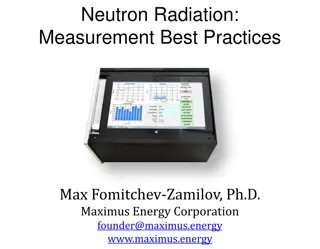Positron Emission Tomography: Applications in Society and Recent Developments
Positron Emission Tomography (PET) is a medical imaging technique focusing on metabolic differences in the body. By using positron-emitting radioisotopes, PET can detect how molecules are taken up by healthy and cancerous cells, aiding in accurate tumor localization with lower doses. The evolution o
0 views • 6 slides
Advanced Fission Experiments at University of Michigan
The University of Michigan, under the guidance of Dr. Sara A. Pozzi, conducts cutting-edge fission experiments leveraging organic scintillation detectors. These detectors offer advantages such as nanosecond-scale response times, energy proportionality, and scalability. The experiments focus on impro
0 views • 4 slides
Advances in X-ray Phase Contrast Imaging with Single Crystal Scintillators
This presentation discusses the use of single-crystal scintillators in X-ray imaging systems to optimize spatial resolution and efficiency. By utilizing modified FO plates and single crystals, a new paradigm has been introduced to enhance the point-spread function while maintaining or improving effi
0 views • 43 slides
Overview of Observational Techniques and Student Talks in Astronomy
This content covers observational techniques, student talks, and dates related to various astronomical topics such as gamma-ray astronomy, basics of gamma-ray interaction, scintillators and solid-state detectors, Compton telescopes, and pair telescopes. It provides insights into the main processes i
0 views • 23 slides
Overview of GRANDproto Project Workshop on Autonomous Radio Detection
GRANDproto project workshop held in May 2017 focused on improving autonomous radio detection efficiency for the detection of extensive air showers (EAS). Issues such as detector stability and background rates were discussed, with the goal of establishing radio detection as a reliable method for EAS
1 views • 14 slides
Advanced Calorimeter Technology for Particle Detection
Cutting-edge calorimeter technology for high-energy physics experiments is discussed in this content. The focus is on radiation-hard crystal scintillators and plastic scintillator-based Shashlik technology used in the present ECAL. Details about the requirements, materials, irradiation tests, and ad
0 views • 16 slides
Designing Veto Cosmic Ray Detector for JPET Using GEANT4 Simulations
Creating the Veto Cosmic Ray Detector for JPET involves designing the current version of Veto JPET, incorporating 42 scintillators, detecting 4 GeV cosmic muons, generating cosmic muon distribution, and simulating energy deposition inside the veto scintillators. The process includes particle generat
0 views • 26 slides
Investigation of PMT Rate Dependence in Calorimetry Study
Anastasia Basharina-Freshville from University College London conducted a study on the rate dependence of PMT response in a calorimetry experiment. The investigation involved pulsing an LED into a scintillator optically coupled to a PMT at various voltages and peak currents to analyze the behavior o
0 views • 22 slides
DarkLight CM TRIUMF May/June 2023 Prototype Scintillator Development Details
The DarkLight project at TRIUMF in May/June 2023 involves the development of prototype scintillators with specific requirements for triggering, timing adjustments, and readout capabilities. Various images depict different components such as SiPMs, front-end readout cards, and TOF Alpha bars. The pro
0 views • 14 slides
Compact Muon Radiography System for Investigation of Nuclear Reactor Fuel Status
A seminar presentation at LAL on May 23, 2013, discussed a compact muon radiography system designed for investigating the status of nuclear reactor fuel. The system, developed by researchers from the University of Tsukuba, involved the use of trackers with scintillators and muon detectors at various
0 views • 56 slides
Neutron Radiation Measurement Guidelines and Techniques
Understanding neutron detection basics, absorption cross-section, moderators, positioning, and common detector types is crucial for accurate measurements. Neutrons vary in energy levels, requiring specific detection techniques. Thermal neutrons are easier to detect than fast ones, with materials lik
0 views • 34 slides
KLM Crate Utilization Belle Crate Configuration Overview
The KLM Crate Utilization Belle Crate Configuration involves reusing locations with specific changes: removal of endcap 6U crates, installation of new 9U (COPPER) crates for endcap and barrel scintillators, and relocation of ARICH and TOP FTSW to 8 crates each. Check out the detailed changes and con
0 views • 5 slides
CALO Upgrade R&D Plans and Solutions for Future ECAL Technology Selection
The R&D initiative focuses on selecting technology for the central area of Phase II ECAL, aiming for high luminosity and detector performance. Various solutions are proposed, including sampling calorimeters with innovative materials like Ce-doped fibers and radiation-hard scintillators. Plans involv
0 views • 12 slides
Advanced Characterization of Segmented Ge Detectors by Hans-Jürgen Wollersheim
Explore the comprehensive characterization of segmented Ge detectors led by lecturer Hans-Jürgen Wollersheim. Uncover the motivation behind the project, the choice of gamma cameras, and the specifications required for optimal performance. Discover the use of LYSO scintillators and Gem-imaging techn
0 views • 33 slides













